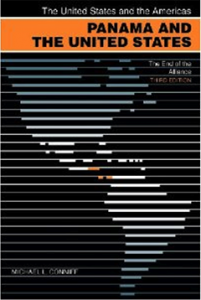 Review by Joe B. Johnson
Review by Joe B. Johnson
Panama and the United States: The End of the Alliance by Michael L. Conniff, University of Georgia Press: Athens, GA 30602, ISBN 978-0-8203-4414-0, 241 pp. (Paperback), $24.95
Panama and its trans-Isthmian canal sat at the center of United States foreign policy concerns in 1977-78 when the Carter-Torrijos treaties were signed and ratified, and again ten years later in the run-up to Operation Just Cause. After the U.S. invasion the relationship receded in the public consciousness. This history by a leading specialist offers interesting perspectives as the U.S. withdraws from two very different combat zones half a world away.
This is the third edition of Conniff’s account of U.S.-Panama relations, but his first look at the period since Panama gained control of the Canal and American forces left the country in 1999. That “post- treaty” period, running through 2011, gets only 16 pages. However, the book is one of the few comprehensive treatments of bilateral relations to cover (as Paul Harvey used to put it) “the rest of the story.”
The book is far from a dry chronicle of treaties. Panama is a colorful place, full of outlandish characters, and Conniff’s inclusion of social movements, mores, and personal factors behind the scenes make a readable account. Conniff lived and worked in Panama in the mid-1960s and traveled there afterward, cultivating original sources. He spent time in Panama on a Fulbright grant when I served at the U.S. Mission in the mid-1990s.
“The End of the Alliance” refers to the dissolution of a longstanding close working relationship between the two governments after recovery from Operation Just Cause. Conniff details Panamanians’ longstanding dependence on their American partners: frustration at U.S. dominance and at the same time desire for protection from their own leaders. Most Panamanians approved of the U.S. overthrow of General Manuel Noriega, Conniff finds. However, recurring expectations on both sides that the U.S. would retain a presence after 1999 never came to pass.
So the Treaties expired not with a bang but with a whimper. At the canal turnover ceremony on December 31, 1999, the senior U.S. official was not the President but Attorney General Janet Reno. Since then, Panamanian GDP more than doubled and the Panama Canal Authority made the waterway far more profitable than it was under the U.S. government. Conniff concludes, “The United States is no longer a dominant partner” in the relationship. Perhaps the word “alliance” no longer belongs in the book’s title at all.
The public will hear more about the Panama Canal as the opening of new locks and other works to accommodate giant ships approaches – probably in 2015. The media will no doubt point up continuing problems of inequality and poor social investment as a presidential election approaches, also set for 2014. However, Conniff credibly draws a favorable balance sheet of Panamanian leadership through 2011, noting two free and fair presidential elections since 1999 as well as the aggressive economic growth.
The perceptive reader may search U.S.-Panamanian relations for insights into the United States’ more recent experience in Iraq and Afghanistan. The book describes the disbanding and partial reconstitution of the Panama Defense Forces after the invasion; the grand post-invasion U.S. aid scheme and its subsequent downsizing; and official and public anxiety over American interests in the smooth and economical functioning of the Canal.
Direct parallels with Afghanistan and Iraq are harder to draw. Because of heavy interference from outside since the early 1800s – first France and then the United States – Panama became a multi-racial society with a high proportion of U.S.-educated business executives and engineers.
For the American reader especially, Conniff’s account of the end of the alliance offers a good approach to learn about Panama today.![]()
American Diplomacy is the Publication of Origin for this work. Permission to republish is freely granted with credit and a link back to American Diplomacy

